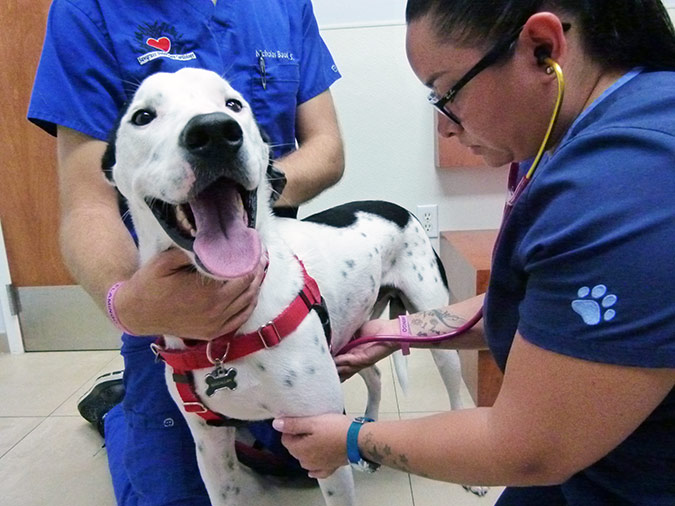What You Need to Understand About Veterinary Services: A Review of Diagnostic Tools and Procedures
Veterinary solutions play an essential duty in preserving the wellness of animals. Normal examinations can disclose covert wellness issues early. Numerous analysis tools and treatments, such as blood tests and imaging methods, provide crucial insights right into a pet's wellness. Recognizing these methods is crucial for animal proprietors. What details diagnostic procedures are most generally used, and exactly how can they affect a pet dog's treatment plan?
Importance of Routine Vet Check-Ups
While lots of pet dog owners might take too lightly the significance of regular veterinary examinations, these appointments are necessary for maintaining a pet's overall wellness. Regular visits to the vet permit very early discovery of possible health and wellness problems before they intensify right into severe issues. Routine exams commonly include vaccinations, which are very important for stopping infectious illness that could significantly impact an animal's wellness. Additionally, these appointments provide a possibility for veterinarians to examine the pet's weight, oral health and wellness, and general condition, guaranteeing that the pet is thriving. During these gos to, family pet proprietors can likewise receive useful recommendations on diet plan, exercise, and preventative care tailored to their particular animal's needs.
Common Diagnostic Procedures in Veterinary Medication
In veterinary medicine, exact medical diagnosis is crucial for reliable therapy. Common analysis treatments include blood testing strategies, progressed imaging modern technologies, and urinalysis, each playing a substantial duty in recognizing wellness concerns. Understanding these methods boosts the ability to provide ideal take care of pet patients.
Blood Checking Methods
Blood testing strategies offer as necessary diagnostic tools in vet medicine, making it possible for vets to evaluate the wellness of animals properly. These methods involve gathering blood samples to assess different components, such as white and red blood cells, platelets, and biochemical markers. Typical tests include full blood counts (CBC), which examine overall health and wellness and detect infections, and biochemical panels, which examine body organ function and metabolic condition. Additionally, serological examinations can identify particular conditions through antibody detection. Blood testing is minimally invasive and gives important details that aids in identifying problems, checking health standing, and evaluating actions to treatments. Generally, these techniques play a vital role in making sure excellent look after animals and animals alike.
Imaging Technologies Made Use Of
Analysis imaging technologies are important devices in vet medication, matching blood screening strategies by offering visual understandings right into a pet's internal structures. Typical imaging techniques consist of X-rays, which work for evaluating bone fractures and discovering foreign items, and ultrasound, which permits real-time visualization of soft cells and body organs. Magnetic resonance imaging (MRI) provides comprehensive images of complex anatomical areas, specifically in neurological analyses. Computed tomography (CT) gives cross-sectional images, boosting analysis precision for different conditions. Each of these innovations aids veterinarians in diagnosing diseases, planning therapies, and monitoring recovery. By including imaging modern technologies, veterinary experts can better evaluate an animal's health and make educated choices concerning their treatment.
Urinalysis and Diagnostics
Urinalysis works as a crucial diagnostic device in veterinary medicine, supplying important insights right into a pet's general health and assisting in the discovery of different conditions. This non-invasive treatment evaluates urine examples to examine kidney function, hydration standing, and metabolic conditions. Common components checked out include specific gravity, pH degrees, glucose, healthy proteins, and the presence of blood or germs. Irregular searchings for can show problems such as urinary system infections, diabetes mellitus, or kidney condition. To enhance diagnostic precision, urinalysis is typically performed along with other examinations, such as blood work and imaging researches. Early detection via urinalysis can lead to timely treatments, enhancing the prognosis for several veterinary people. It is a crucial element of detailed veterinary treatment.
Comprehending Blood Examinations and Laboratory Evaluation
Recognizing blood tests and research laboratory analysis is crucial in vet medicine as it helps in diagnosing different wellness conditions in animals. Various types of blood tests offer crucial info regarding a pet's internal state, while translating laboratory results calls for mindful consideration of many variables. This area will check out the kinds of blood examinations readily available and the importance of their outcomes.
Sorts Of Blood Tests
Blood tests play a crucial duty in vet medication, offering necessary understandings right into a pet's health and wellness status. Different sorts of blood examinations are utilized, each serving various purposes. Total blood matters (CBC) evaluate general wellness and identify conditions such as anemia or infection. Biochemical profiles assess organ function by determining electrolytes and enzymes, using insights into metabolic health and wellness. Serological examinations recognize specific antibodies or microorganisms, helping in the medical diagnosis of infections or autoimmune conditions. Blood typing guarantees safe transfusions, while coagulation examinations assess the blood's capability to embolisms, crucial for surgeries. These tests collectively enhance diagnosis, therapy preparation, and monitoring of an animal's wellness, highlighting the relevance of comprehensive lab evaluation in vet care.

Interpreting Laboratory Outcomes
A comprehensive analysis of laboratory outcomes is important for exact diagnosis and therapy in vet medicine. Translating laboratory results requires an understanding of typical referral arrays and the value of deviations. Blood tests can expose numerous health indicators, such as organ feature, electrolyte equilibrium, and the visibility of infections. Veterinarians should think about the whole professional picture, including the animal's history, health examination searchings for, and any kind of signs and symptoms offered. Variants in results might occur from aspects such as age, type, and underlying wellness problems. Subsequently, lab outcomes must not be watched in isolation but rather as component of an all-encompassing diagnostic method. Precise interpretation allows for tailored treatment strategies and far better end results for vet individuals.
Imaging Techniques: X-rays, Ultrasounds, and Beyond
Imaging methods are vital tools in veterinary medicine, giving essential understandings right into the health and wellness and well-being of animals. Amongst one of the most frequently utilized methods are X-rays and ultrasounds. X-rays are important for visualizing bone frameworks, aiding vets identify cracks, lumps, or foreign objects. This approach is quick and non-invasive, making it suitable for urgent situations.Ultrasounds, on the various other hand, make use of audio waves to create photos of soft cells and organs. This method is particularly useful for checking out the heart, abdomen, and reproductive body organs, enabling vets to evaluate problems like fluid build-up or body organ abnormalities.Beyond X-rays and ultrasounds, progressed imaging techniques such as computed tomography (CT) and magnetic vibration imaging (MRI) are progressively made use of in veterinary practice. These techniques offer in-depth cross-sectional images, boosting the accuracy of medical diagnoses and treatment plans. CT Scans For Dogs. On the whole, imaging techniques play a necessary duty in ensuring efficient vet care
The Function of Biopsies in Diagnosing Pet Dog Health Issues
Precision in identifying health and wellness problems in pets typically pivots on making use of biopsies, which provide conclusive details about tissue problems. A biopsy involves the removal of a little example of tissue for assessment under a microscope, allowing veterinarians to recognize various conditions, including a fantastic read infections, lumps, and inflammatory conditions. This diagnostic tool is necessary for comparing deadly and benign growths, directing treatment decisions, and examining the intensity of a condition.Biopsies can be done using numerous strategies, such as needle desire, incisional biopsies, or excisional biopsies, relying on the location and sort of tissue involved. The choice of method may impact healing time and the amount of tissue accumulated. Inevitably, the details obtained from a biopsy can lead to targeted therapies, improving results for family pets dealing with severe health and wellness difficulties. Vets highlight the value of this treatment in accomplishing precise medical diagnoses and efficient treatment plans.
Advanced Diagnostic Devices: Endoscopy and CT Scans

Advanced analysis tools, such as endoscopy and CT scans, play a necessary role in modern-day vet medicine, offering non-invasive approaches to picture interior frameworks and identify various problems in animals. Endoscopy entails making use of an adaptable tube outfitted with a cam, allowing veterinarians to check out the gastrointestinal tract and respiratory system directly. This method can disclose abnormalities such as lumps, foreign bodies, or inflammation, making it possible for targeted therapy plans.CT scans, on the other hand, utilize sophisticated imaging technology to create comprehensive cross-sectional pictures of the body (CT Scans For Animals). This technique is specifically helpful for reviewing complex frameworks like the mind, back, and joints. By providing high-resolution images, CT scans assist veterinarians in determining issues that may not be obvious with conventional radiography. Together, these sophisticated tools improve diagnostic accuracy, enhance treatment outcomes, and ultimately add to better overall pet health management

Interpreting Examination Outcomes: What Animal Owners Should Know
Understanding examination outcomes can be a challenging task for family pet owners, particularly after sophisticated procedures like endoscopy and CT scans have actually been carried out. Translating these results calls for an understanding of medical terms and a clear understanding of what the findings show regarding the pet dog's health. Vets typically provide descriptions, however the intricacy of the results can still result in confusion.Pet proprietors must actively take part in discussions with their vets, asking concerns to make clear any type of uncertainties. It is necessary to recognize regular versus unusual results and the ramifications for the family pet's therapy strategy. Additionally, recognizing that some results might require additional testing or monitoring can help owners remain informed about their animal's health and wellness journey. Inevitably, a collective strategy between pet owners and vet specialists promotes much better health and wellness results and enhances the general treatment experience for pets.
Often Asked Concerns
How Do I Select the Right Vet Facility for My Family pet?
Selecting the appropriate vet center includes looking into regional choices, reviewing qualifications, going to centers, and examining staff interactions (Board Certified Veterinary Cardiologist). Focusing on referrals from relied on resources can assist guarantee discover this info here the most effective treatment and environment for a pet's wellness requirements
What Should I Do if My Animal Refuses to head to the Vet?
When an animal rejects to head to the vet, it's advisable to continue to be calm, use deals with or toys to entice them, and take into consideration arranging a home go to if anxiety continues. Patience and favorable reinforcement are key.
Exist Telehealth Options for Veterinary Providers?
Telehealth options for veterinary services are progressively available, permitting animal proprietors to talk to veterinarians from another location. These services allow conversations concerning wellness problems, suggestions on small ailments, and follow-ups without needing to visit a facility.
Just how Often Should My Animal Have Dental Check-Ups?
The regularity of dental check-ups for pets usually depends upon their age and breed. Generally, vets suggest yearly oral examinations, although some animals may call for even more constant sees to maintain ideal dental wellness.

What Are the Expenses Connected With Vet Diagnostics?
The prices related to veterinary diagnostics can vary extensively, generally varying from standard tests like blood work to sophisticated imaging methods. Factors influencing costs consist of the facility's area, equipment utilized, and certain examinations needed for each and every pet. look these up Veterinary services play a crucial function in preserving the wellness of pet dogs. While numerous animal owners may undervalue the value of normal veterinary check-ups, these appointments are essential for maintaining an animal's total health. Additionally, these appointments provide an opportunity for veterinarians to evaluate the animal's weight, dental wellness, and total problem, making certain that the pet is thriving. Accuracy in detecting health and wellness problems in family pets typically hinges on the use of biopsies, which provide definitive details concerning tissue abnormalities. Additionally, identifying that some outcomes might need additional testing or surveillance can assist owners stay notified regarding their animal's health trip.
Comments on “Benefits of Early Diagnosis With a Board Certified Veterinary Cardiologist}”